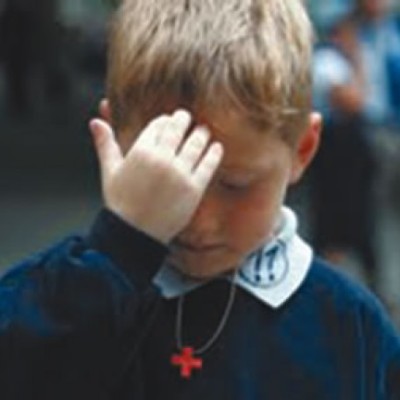Though we here on earth are loathe to hold ourselves up as examples (more false modesty than the real conviction that we have nothing to model), St. Paul is not to slow to say "follow me... the sound pattern of my words and works... the Gospel I proclaimed to you..." St. Paul, who also called himself chief of sinners, was not in the least suggesting that he was sinless or without blame. He depended upon the righteousness of Christ just like the anonymous baptized whose names are known only to God.
It seems to me that one of the chief roles of the pastor in the parish is that of model. I do NOT mean the idea that he has attained some spiritual plateau that others can also reach if only they try hard enough. I do NOT mean to say that the pastor is holier than those who sit in the pews. Rather, the modeling I am talking about has to do with external piety. For example, when they see the pastor make the sign of the cross, they are encouraged to recall their own baptism when God's triune name was placed upon them. When the people see the pastor bow his head at the name of Jesus, they will eventually connect this gesture to St. Paul's own words (at the name of Jesus every knee shall bow. . . etc...). When they see the pastor genuflect, they see the response of the faithful to the incarnation (if they can just get over the knee jerk reaction that suspects him of being a Romanist). When they see the piety of the pastor displayed in the ritual gestures of the liturgy while in the chancel, they have a model for their own piety and worship. When they see the Pastor hold up the Word of God as they proclaim "The Word of the Lord," they understand that his voice has become a tool of God to speak to them.
Lutherans are certainly not people to establish rules that would require the folks in the pew to make the sign of the cross, bow, genuflect, kneel, etc... but when they see the pastor do these things they have an example to follow. Many would appreciate these gestures but do not know how to do them. The pastor models this before the people -- the fuller ceremonial of which they may only watch or participate in part.
Nowhere does this hit home more than with the altar servers who assist in the chancel -- from acolytes to lay assisting ministers. The modeling of the pastor taking seriously what happens in worship leads the child and the adult who may be thrust into a less familiar role within the liturgy to know how to exercise this assisting role. The youth who sits with me as an acolyte watches me pray, sees me open the book and follow the order of worship, sing the hymns, and, guess what, they tend to follow!
As parents we model all sorts of things for our children -- the teaching without words that happens for good or for ill as they see what we do, hear what we say, and watch how we do these. As pastors we do this as well. The reverence we show is not without impact. It teaches. We model this before those who are with us in the chancel and we model this before those in the pew and they learn from it. Piety for the baptized includes reverence learned from the our fathers in the faith. This is not an artificial piety reserved only for certain space but at least for that space and it is mirrored in other things outside the chancel (at least that is the hope).
So I would say to the pastor who finds resistance to such reverence that the best thing he has going for him is his own modeling of this piety and reverence before the people -- especially the youth. When the pastor treats the things of God casually, you know what the message is -- this is not serious, this is not important, or this is a joke. When the pastor treats the things of God with reverence and the devotion of faith, you also know what the message is -- God is here, speaking through His Word and acting through His Sacraments to deliver His gifts to His people. And I would ask those who may be tempted to dismiss such ritual or ceremonial as Roman hangovers to step back from judgment, watch, and see. They might learn just how Lutheran these things are.

1 comment:
As a former Roman Catholic, once I became born again and started attending the LCMS, I noted how only a small number of Lutherans in the pews made the sign of the cross. Most pastors in the few LCMS churches I have attended do indeed practice it. I think some of us in the pews see it as something for the Lutheran clergy, but optional for the rest. I don't understand why. I have not done it since I left the Catholic Church, however, I sometimes feel like we should bring it back. Luther taught we should make the sign of the cross when we begin prayers, and I would like to hear LCMS pastors talk about it. Perhaps, with encouragement from the pastors, many Lutherans would follow suit. After all, many of the ceremonial traditions already practiced came from our Catholic past and are not unbiblical or worthy of criticism.
Post a Comment